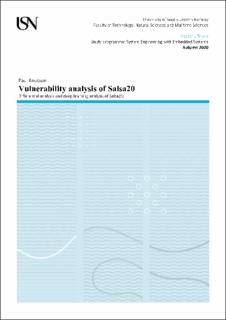Vulnerability analysis of Salsa20 : differential analysis and deep learning analysis of Salsa20
Master thesis
Published version
Permanent lenke
https://hdl.handle.net/11250/2730004Utgivelsesdato
2020Metadata
Vis full innførselSamlinger
Sammendrag
This work attempts to address the research question of how secure the current
solutions in lightweight cryptography are, and speci_cally, if Salsa20 is a
su_ciently secure algorithm for its intended purposes.
We perform a state of the art survey on the current landscape of lightweight
cryptography and a survey of the cryptanalysis most relevant to these kinds
of crypto systems. We take a closer look at the ARX-based stream cipher
Salsa20, analyse its security and give recommendation based on the results.
We implement two analyses against both Salsa20 and one of its code components,
the quarter-round function. While breaking the quarter-round may
not be useful for breaking Salsa20, it gives us an idea of the viability of the
analysis. The two analysis methods are:
1. Di_erential analysis using the Hamming distance.
We found that the quarter-round, when treated like an encryption algorithm,
had an insu_cient avalanche e_ect and is easily distinguishable
from random noise for chosen plaintexts. We could not _nd any indication
the full Salsa20 algorithm su_er from these e_ects.
2. Deep learning-based analysis using a context aggregation network.
This analysis used images (some generated from random noise, some
actual images), encrypted them, and tested if the context aggregation
network (CAN) was able to learn and reconstruct parts of the original
images or plaintexts. The results indicated this method is not viable
against either Salsa20 nor its quarter-round function.
We therefore conclude that these forms of analysis does not seem e_ective
against Salsa20.
